Well Hello! Do you recognize me?... No?? Ohhh you remember...Uncle Fred's party?...the Twister game?... hmmm... how quickly they forget... no not really.. I'm a GIRAFFE! I am so happy that you stopped in to visit!
I am so happy that you stopped in to visit!
I'd love to share some facts about myself, so you can not only learn about me and my long necked friends, but that you may learn how to save us and our habitat.
We can sure use the help from you good folks.

So, let's start learning....
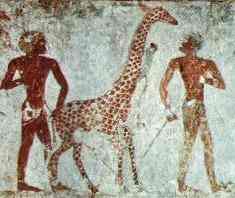 My scientific name is camelopardalis, is the Latin version of cameleopard.
My scientific name is camelopardalis, is the Latin version of cameleopard.
When we were first brought to Rome in 46 B.C., we were thought to be as big as a camel, with spots like a leopard.
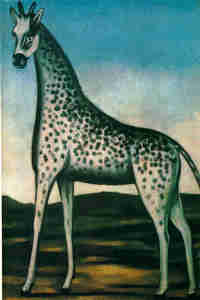 Although humans have long since learned that we are not a combination of these animals, the name stuck anyway.
Although humans have long since learned that we are not a combination of these animals, the name stuck anyway.
We are found in southern Ethiopia and northern Kenya, and the surrounding region. We like flat, grassy, savannas.

We are found mainly throughout arid and dry savanna zones south of the Sahara, wherever trees occur.
We've been eliminated from most of West African and southern Kalahari range but still are reasonably common even outside wildlife preserves.
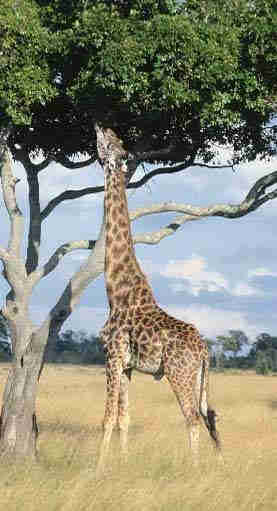 We are the tallest mammal. We have very long necks with a short, upstanding mane, high shoulders sloping steeply to our hindquarters; our long legs nearly equal in length.
We are the tallest mammal. We have very long necks with a short, upstanding mane, high shoulders sloping steeply to our hindquarters; our long legs nearly equal in length.
Males or "bulls" weigh 2420-4250 pounds, with a shoulder height of 9-11 feet, the top of the horns gives us a total height of up to 17-19 feet.
 Females or "cows" weigh 1540-2600 pounds, shoulder height of 8-10 feet, with a total height of 16-17 feet.
Females or "cows" weigh 1540-2600 pounds, shoulder height of 8-10 feet, with a total height of 16-17 feet.
Our necks and heads weigh 500 pounds. We have a long, prehensile tongue. Our Horns are solid bone and skin covered.
 Female's horns are thin and tufted; male's are thick and bald on top, our horns can be up to 5 inches long. Our tails have long tassels.
Female's horns are thin and tufted; male's are thick and bald on top, our horns can be up to 5 inches long. Our tails have long tassels.
We have only 7 bones in our necks, the same number as humans! Our circulatory system is specially adapted to our long neck.
 We have elastic blood vessels in our neck and head to handle changes in blood pressure due to head swings.
We have elastic blood vessels in our neck and head to handle changes in blood pressure due to head swings.
We have a special valve in the blood vessels of our neck. This special valve allows us to bend WAY down to get a drink of water without passing out from the rush of blood to our brain.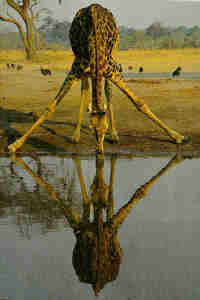
When we sleep, we only lie down for 2 to 10 minutes, and we only sleep for up to 3 minutes per day.
If we fall over flat then we can't get up and will die.
We do not usually sit on the ground because it is difficult for us to get away from predators quickly.
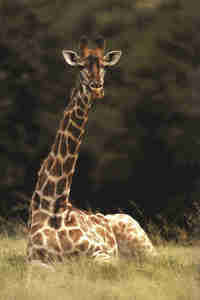 Mother giraffes will scold the young ones when they sit or lay.
Mother giraffes will scold the young ones when they sit or lay.
We have scent glands on our eyelids, nose and lips.
Our color varies from brown to a rich chestnut (old males are darker, even black).
We have an intricate tapestry of patches and blotches of lighter hair, patterns are unique in each of us, just like a fingerprint!
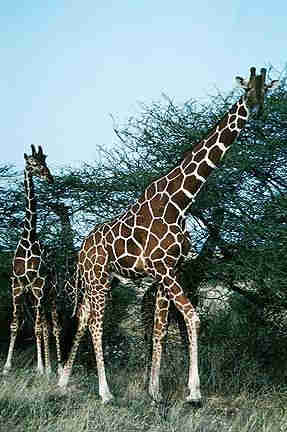 There are "eight" recognized races, the reticulated (G. c. reticulata) of north Kenya which are most distinctive for it's latticework of thin lines separating dark patches is also most unlike the markings of any other mammal.
There are "eight" recognized races, the reticulated (G. c. reticulata) of north Kenya which are most distinctive for it's latticework of thin lines separating dark patches is also most unlike the markings of any other mammal.
The familiar klasai (G. c. tippelskirchi) of East Africa has the most irregular pattern.
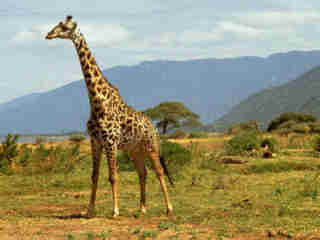 There are nine different giraffe spot patterns: Kordofan, Nubian, Nigerian, Angolan, Masai, Reticulated, Thornicroft's/Baringo, Rothschild's, and Southern.
There are nine different giraffe spot patterns: Kordofan, Nubian, Nigerian, Angolan, Masai, Reticulated, Thornicroft's/Baringo, Rothschild's, and Southern.

We love foliage! Of course with our long necks, where we can reach to eat is beyond the reach of all other terrestrial browsers except the elephant.
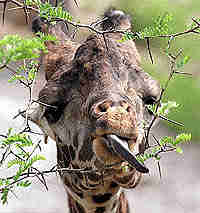 Our 18 inch tongue and a modified atlas~axis joint that lets our head extend vertically further increases our height advantage.{kinda like Inspector Gadget}
Our 18 inch tongue and a modified atlas~axis joint that lets our head extend vertically further increases our height advantage.{kinda like Inspector Gadget}
We can browse crowns of small trees; the big bulls can reach 19 feet, a yard higher than cows. We feed mainly on broad leafed deciduous foliage in the rainy season and on evergreen species during other seasons.
We feed mainly on broad leafed deciduous foliage in the rainy season and on evergreen species during other seasons.
Our menu includes 100 species but Acacia and Combretum trees are mainstays in most areas.
These trees are very thorny. The thorns are sharp enough to puncture a car tire, but will not hurt our tongues.
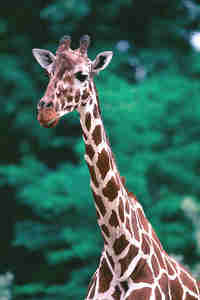 Our narrow muzzle and flexible upper lip, along with our prehensile tongue, enable us to consume the most nutritious leaves, up to 75 pounds per day!
Our narrow muzzle and flexible upper lip, along with our prehensile tongue, enable us to consume the most nutritious leaves, up to 75 pounds per day!
But, this is necessary to sustain our great bulk.
Our tongues are pink and black and are 18-22 inches long. We use our tongues to grab our food.
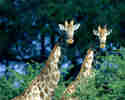 We eat in the morning and night, but we rest in the afternoon.
We eat in the morning and night, but we rest in the afternoon.
We have 4 stomaches just like cows (our cud needs to travel all the way up our neck!)
We drink every 2 to 3 days when water is available but we can also extract water from green leaves.

What do we do during the day? Well, the females spend just over half a 24 hour day browsing for food, males somewhat less about 43% of the day.
Well, the females spend just over half a 24 hour day browsing for food, males somewhat less about 43% of the day.
Night is mostly spent lying down ruminating, especially hours after dark and before dawn.
Bulls will spend about 22% of the 24 hours walking, compared to 13% for cows; the extra mileage goes into searching for cows to mate with.

We are nonterritorial and sociable, living in loose, open herds.
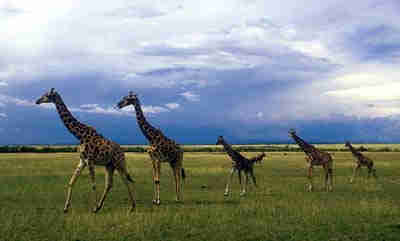 At a given moment we may be in a herd composed of all males, all females, females and young, or of both sexes and all ages or all alone if it is a mature bull or a cow guarding a new calf.
At a given moment we may be in a herd composed of all males, all females, females and young, or of both sexes and all ages or all alone if it is a mature bull or a cow guarding a new calf.
There are no leaders and minimum coordination of herd movements.
Height and excellent eyesight enable us to maintain visual contact at long distances a dozen of us may be dispersed over a 2 mile area of the savanna and still be in a herd.
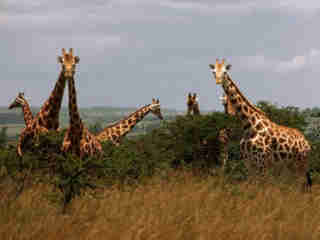 In fact we rarely cluster together unless we happen to be attracted to the same tree, nervous over the presence of lions, or aggregated in the open.
In fact we rarely cluster together unless we happen to be attracted to the same tree, nervous over the presence of lions, or aggregated in the open.
Even at rest, our herd members stay over 20 yards apart.

As usual, females are more sociable than males and rarely out of sight of other females.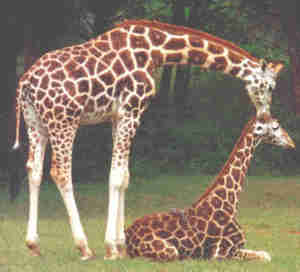
Mothers of small calves associate most consistently, at least partly because of a mutual attraction between youngsters that results in creches of up to 9 calves.
Average spacing between calves is usually less than 10 yards.
Males remain in maternal herds until they outgrow their resemblance to females at about 3 years, after which they join bachelor herds.
They eventually leave their natal range, whereas females stay put.

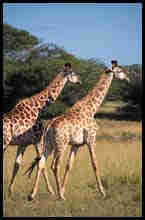 We have just 2 gaits, a walk and a gallop. Our long legs and short trunk decree an ambling walk, with the entire weight Supported alternately on left and right legs, as in camels.
We have just 2 gaits, a walk and a gallop. Our long legs and short trunk decree an ambling walk, with the entire weight Supported alternately on left and right legs, as in camels.
Our long necks move in synchrony to maintain balance.
In galloping we can reach a top speed of 37 mph, forelegs and hind legs work in pairs like a running rabbit's.
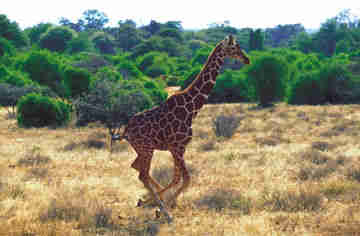 Getting a drink is a bit tricky, we must either straddle or bend our forelegs. The same is true of the okapi, disproving the idea that the giraffe's extra long neck and legs are the reason they must drink this way.
Getting a drink is a bit tricky, we must either straddle or bend our forelegs. The same is true of the okapi, disproving the idea that the giraffe's extra long neck and legs are the reason they must drink this way.

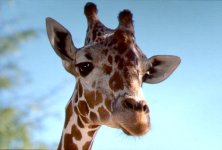 Year round, with rainy season being the conception peak.Females will have their first pregnancy in their fourth year, gestation is 14 to 14.5 months.
Year round, with rainy season being the conception peak.Females will have their first pregnancy in their fourth year, gestation is 14 to 14.5 months.
Males begin competing for matings at 7 years, senior males have a decided weight and height advantage over the younger males.
 The male's head gains weight with age, through bone deposition the process that creates the extra knobs on an old bull's head enabling a bull to deliver ever heavier blows during a possible sparing contest with other bulls.
The male's head gains weight with age, through bone deposition the process that creates the extra knobs on an old bull's head enabling a bull to deliver ever heavier blows during a possible sparing contest with other bulls.
Combat is rare, though, as bulls from the same area all know their place in a rank hierarchy established through daily contests while maturing in bachelor herds.
By the time a female is ready to mate, the local alpha male has usually supplanted all lesser rivals without ever coming to blows, which can been seen as neck wrestling.

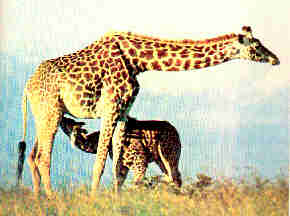 We Serengeti giraffes are not so typical, our cows return to the same location each time she calves.
We Serengeti giraffes are not so typical, our cows return to the same location each time she calves.
Calves are 6 feet tall when the are born! and when born, land on their head! {ouch!}
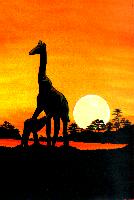 The first week or so a calf lies out half the day and most of the night, carefully guarded by its mother, which usually stays within 11 to 25 yards of her offspring for the first 2 weeks, although mothers may stay over 100 yards from a hidden calf and even leave it alone to go to water.
The first week or so a calf lies out half the day and most of the night, carefully guarded by its mother, which usually stays within 11 to 25 yards of her offspring for the first 2 weeks, although mothers may stay over 100 yards from a hidden calf and even leave it alone to go to water.
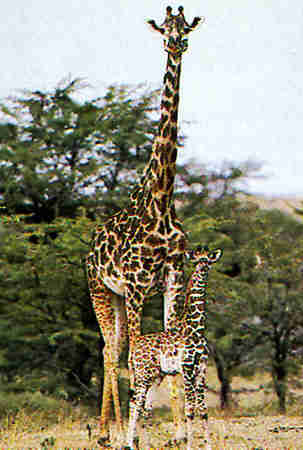 The increased security of a maternity group guarding calves in a creche allows a mother to go further and stay away longer.
The increased security of a maternity group guarding calves in a creche allows a mother to go further and stay away longer.
But calves are rarely left totally unattended; absent mothers usually return before dark to suckle their offspring and stay with them overnight.
Although we are weaned as yearlings and nutritionally independent at 16 months, the maternal bond lasts up to 22 months.

Sadly, 50 to 75% of our calves fall prey to lions and spotted hyenas in their first months,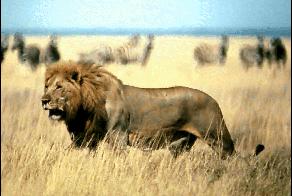 despite hiding and the mother's determined defense.
despite hiding and the mother's determined defense.
Adults are too big to be regular prey, a mother will stand over and defend her calf against lions, which run the risk of being kicked to death if they get within striking distance.
Females never use their horns, and males only use theirs in contests with peers.

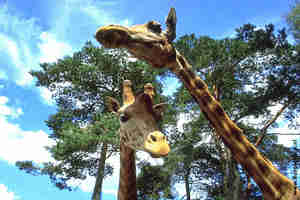 We are great communicators! We communicate by sight, scent, and sound.
We are great communicators! We communicate by sight, scent, and sound.
The idea that we are mute is a myth. Though normally silent, our calves bleat and make a mewing call,
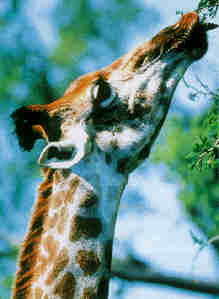 cows seeking lost calves bellow, and courting bulls may emit a raucous cough.
cows seeking lost calves bellow, and courting bulls may emit a raucous cough.
We also give alarm snorts, and moaning, snoring hissing, and flutelike sounds.

We actually have a relative! Isn't she cute! The rare Okapi, Okapia johnstoni. They are confined to a small region within the Congo Basin and only discovered early this century, can you see the family resemblance? ha ha
The Okapi have a much shorter neck, and are somewhat solitary animals.
This is our only known living relative, it is found in the immense Ituri Forest of the northeastern Democratic Republic of Congo.
It has a velvety, reddish-brown coat and black and white, horizontally striped legs.
It has a long, bluish-black prehensile tongue it uses to clean its ears as well as wrap around high acacia branches.
The San Diego Zoo, one of only 25 zoos in the world to exhibit Okapi,
contributes to the DRC's Okapi Wildlife Reserve to help preserve this rare animal and its habitat.

Well I have certainly saved the best for last! Would you like to join me for brunch?
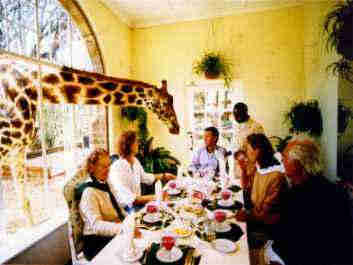
The Giraffe Manor was built in 1932 by Sir David Duncan.
It is situated on 120 acres of land just a few miles from the centre of Nairobi, Kenya's capital city.
In 1974 Jock Leslie-Melville, grandson of a Scottish earl, and his wife Betty, who also founded the African Fund for Endangered Wildlife (AFEW), bought the Manor.
They then moved five babies of our highly endangered Rothschild giraffe to their property where they have been successfully reared and they now have their own babies.
When Jock died, Betty decided to open her house, now called the Giraffe Manor, to visitors.
Exclusive, spacious and elegant, it is the only place in the world that you can feed me and my long necked friends from your second floor bedroom window, over the lunch table, and at the front door.
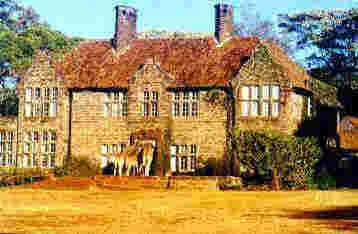
Guests can feed and photograph us and the Warthogs at the Manor, and also wander through the adjoining primeval forest to view the bushbuck, dik dik, and more than 180 species of birds.
The fee for staying at the Giraffe Manor includes accommodation, all meals (prepared by a gourmet chef), tea, wine and cocktails. - Lunches, teas, cocktails and dinners are also available to groups of fifteen or more.
And of course you have the pleasure of dining with ME!
Many famous folks have come to see us, like Margaret Mead, Walter Cronkite, Brooke Shields, Richard Chamberlain, Steve Sondheim, Lee Remick and Johnny Carson - and many others.
Next time you're in Africa, come see me!
Thank you for visiting and learning about me....Please don't forget to visit "Giraffic Park" before you leave!!

